| dc.contributor.author | Blumstein, Angela Marie | |
| dc.coverage.spatial | Utah | |
| dc.coverage.spatial | Utah | |
| dc.coverage.spatial | Utah | |
| dc.date.accessioned | 2023-09-18T17:00:26Z | |
| dc.date.available | 2023-09-18T17:00:26Z | |
| dc.date.created | 2003 | |
| dc.date.issued | 2003 | |
| dc.identifier.uri | https://hdl.handle.net/11244/339582 | |
| dc.description | Thesis (M.S.)--University of Oklahoma, 2003. | |
| dc.description | Includes bibliographical references (leaves 47-52). | |
| dc.description.abstract | The objective of this study is to test models for the origin of widespread
remagnetizations in the Mississippian Deseret Limestone. The Delle Phosphatic Member
of the Deseret Limestone is a source rock for hydrocarbons in other units in Utah and
entered the oil window in the Early Cretaceous during the Sevier orogeny based on
modeling studies. Paleomagnetic results from the Deseret Limestone and the
stratigraphically equivalent Chainman Shale in central and western Utah indicate that the
unit contains two dual polarity ancient magnetizations, interpreted to be chemical
remanent magnetizations ( CRMs) based on low burial temperatures. The demagnetization
characteristics and rock magnetic studies indicate that the CRMs reside in magnetite.
Three fold tests from western Utah indicate the presence of a pre-folding Triassic to
Jurassic CRM. Geochemical (87Sr86 Sr, 6 13 C, and 6 18 0) and petrographic analyses
suggest that these rocks are unaltered. The age of the CRM is just prior to the modeled
time for organic matter maturation in the unit. Therefore, this CRM is interpreted to be
the result of burial diagenesis, such as an early stage of organic matter maturation within
the source rock or clay alteration. A second younger CRM in western and central Utah is
post-folding based on a regional fold test. This CRM is Late Cretaceous to Early Tertiary
in age and the timing overlaps with the oil window based on the thermal modeling.
These results are also consistent with a connection between organic matter maturation
and remagnetization, and the geochemical ( 87Sr86Sr, 613 C, and 6.18 0) and petrographic
results from rocks with this component show no evidence for alteration by externally
derived fluids. The results of this study support the hypothesis that widespread burial
diagenetic processes are associated with pervasive CRMs. In addition, this study
indicates that paleomagnetism can be used to determine the timing of burial diagenetic
processes, which can benefit hydrocarbon exploration efforts. | |
| dc.format.extent | ix, 52 leaves | |
| dc.format.medium | ix, 52 leaves : ill. (some col.), maps ; 29 cm. | |
| dc.language.iso | eng | |
| dc.subject.lcsh | Paleomagnetism | |
| dc.subject.lcsh | Diagenesis--Utah | |
| dc.subject.lcsh | Magnetization--Utah | |
| dc.subject.lcsh | Limestone--Utah | |
| dc.subject.lcsh | Geology, Stratigraphic--Mississippian | |
| dc.title | Paleomagnetic dating of burial diagenesis in Mississippian carbonates, Utah | |
| dc.type | Text | |
| dc.contributor.committeeMember | Smart, K.J. | |
| dc.contributor.committeeMember | Engel, M.H. | |
| dc.contributor.committeeMember | Chair, R.D. Elmore | |
| ou.group | School of Geology and Geophysics | |
